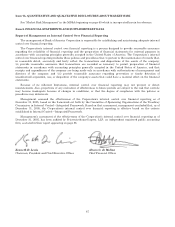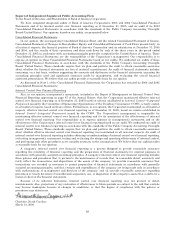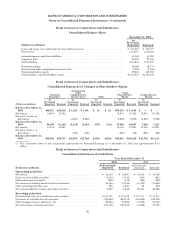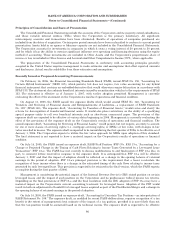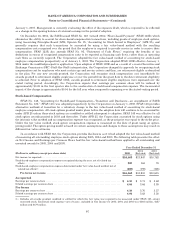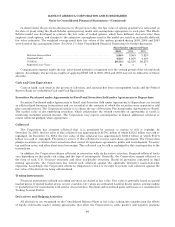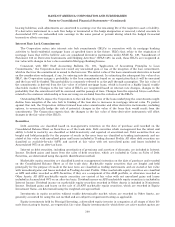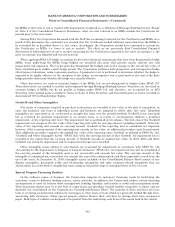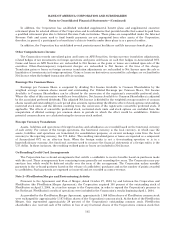Bank of America 2005 Annual Report Download - page 132
Download and view the complete annual report
Please find page 132 of the 2005 Bank of America annual report below. You can navigate through the pages in the report by either clicking on the pages listed below, or by using the keyword search tool below to find specific information within the annual report.BANK OF AMERICA CORPORATION AND SUBSIDIARIES
Notes to Consolidated Financial Statements—(Continued)
Principles of Consolidation and Basis of Presentation
The Consolidated Financial Statements include the accounts of the Corporation and its majority-owned subsidiaries,
and those variable interest entities (VIEs) where the Corporation is the primary beneficiary. All significant
intercompany accounts and transactions have been eliminated. Results of operations of companies purchased are
included from the dates of acquisition. Certain prior period amounts have been reclassified to conform to current period
presentation. Assets held in an agency or fiduciary capacity are not included in the Consolidated Financial Statements.
The Corporation accounts for investments in companies in which it owns a voting interest of 20 percent to 50 percent
and for which it has the ability to exercise significant influence over operating and financing decisions using the equity
method of accounting. These investments are included in Other Assets and the Corporation’s proportionate share of
income or loss is included in Other Income and Accumulated Other Comprehensive Income (OCI), where applicable.
The preparation of the Consolidated Financial Statements in conformity with accounting principles generally
accepted in the United States requires management to make estimates and assumptions that affect reported amounts
and disclosures. Actual results could differ from those estimates and assumptions.
Recently Issued or Proposed Accounting Pronouncements
On February 16, 2006, the Financial Accounting Standards Board (FASB) issued SFAS No. 155, “Accounting for
Certain Hybrid Instruments” (SFAS 155), which permits, but does not require, fair value accounting for any hybrid
financial instrument that contains an embedded derivative that would otherwise require bifurcation in accordance with
SFAS 133. The statement also subjects beneficial interests issued by securitization vehicles to the requirements of SFAS
133. The statement is effective as of January 1, 2007, with earlier adoption permitted. Management is currently
evaluating the effect of the statement on the Corporation’s results of operations and financial condition.
On August 11, 2005, the FASB issued two exposure drafts which would amend SFAS No. 140, “Accounting for
Transfers and Servicing of Financial Assets and Extinguishments of Liabilities—a replacement of FASB Statement
No. 125” (SFAS 140). The exposure draft, “Accounting for Transfers of Financial Assets,” would revise and clarify the
criteria for derecognition of transferred financial assets. It would also place restrictions on the ability of a qualifying
special purpose entity to roll over beneficial interests such as short-term commercial paper. The provisions of this
exposure draft are expected to be effective at various dates beginning in 2006. Management is currently evaluating the
effect of the provisions of the exposure draft on the Corporation’s results of operations and financial condition. The
second exposure draft, “Accounting for Servicing of Financial Assets,” would permit, but not require, an entity to account
for one or more classes of servicing rights (i.e., mortgage servicing rights, or MSRs) at fair value, with changes in fair
value recorded in income. The exposure draft is expected to be issued during the first quarter of 2006, to be effective as of
January 1, 2006. The Corporation expects to utilize the fair value approach for MSRs upon adoption of this standard.
The final statement is not expected to have a material impact on the Corporation’s results of operations or financial
condition.
On July 14, 2005, the FASB issued an exposure draft, FASB Staff Position (FSP) No. FAS 13-a, “Accounting for a
Change or Projected Change in the Timing of Cash Flows Relating to Income Taxes Generated by a Leveraged Lease
Transaction” (FSP 13-a). The FASB has met recently to discuss modifications to and finalization of FSP 13-a due, in
part, to comment letters received in response to the exposure draft. It is anticipated that FSP 13-a will be effective
January 1, 2007 and that the impact of adoption should be reflected as a change in the opening balance of retained
earnings in the period of adoption. FSP 13-a’s principal provision is the requirement that a lessor recalculate the
recognition of lease income when there is a change in the estimated timing of the cash flows relating to income taxes
generated by such leveraged lease. This provision is expected to be retained in the final version, which the FASB expects
to complete during the first quarter of 2006.
Management is considering the potential impact of the Internal Revenue Service’s (IRS) stated position on certain
leveraged leases and the impact of such position on the Corporation and its predecessors’ federal income tax returns.
Depending on the final provisions of FSP 13-a and the final resolution with the IRS, adoption of FSP 13-a may have a
material impact on the Corporation’s current accounting treatment for leveraged leases. Adoption of the FSP would
result in both an adjustment to Goodwill for leveraged leases acquired as part of the FleetBoston Merger and a change in
the opening balance of retained earnings in the period of adoption.
On July 14, 2005, the FASB issued an exposure draft, “Accounting for Uncertain Tax Positions—an interpretation of
FASB Statement No. 109.” The exposure draft, as modified by recent FASB deliberations, requires recognition of a tax
benefit to the extent of management’s best estimate of the impact of a tax position, provided it is more likely than not
that the tax position would be sustained based on its technical merits. The exposure draft is expected to be effective
96



